If you are looking for a tree for your yard or to plant in a garden, there are many different types of trees that you can choose from. Some of these plants produce purple flowers, which are beautiful to look at.
Various kinds of trees are known to have purple flowers. Some of them are the Crape Myrtle, Korean lilac tree, the Lavender Twist, the Mountain Laurel, the Purple Orchid tree, the Purple Lily Magnolia, the Magnolia’s Royal Purple, the Hibiscus tree, and the Purple Leaf Plum.
1. Crape Myrtle
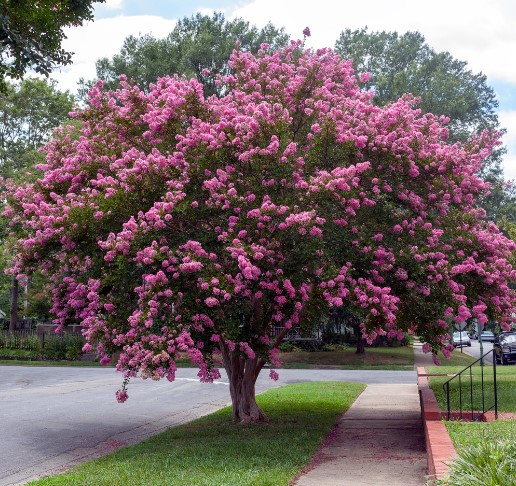
Whether you’re looking for a compact, semi-dwarf shrub or a large flowering tree, you will find the perfect Crape Myrtle for you. They make a beautiful landscape tree, shade tree or informal hedge. They are also easy to care for. They tolerate hot weather and are resistant to fungus and diseases. They grow well in most soil types and are a great yard barrier.
Among the many varieties of Crape Myrtles, there is a variety with purple flowers. First Edition’s Purple Magic has a compact, hearty habit that is resistant to leaf spot and drought. It is also a great, fast growing tree. It will add color to your garden, even in the hottest part of your climate.
Purely Purple Black Diamond Crape Myrtle has deep, dark purple leaves that are resistant to disfiguring diseases. This is a lovely plant that grows well in most soil types, though it does best in full sun. In addition to its beautiful foliage, it is also drought resistant and is resistant to salt-spray.
Infinitini Purple Crape Myrtle has vivid purple flowers that will create a wonderful focal point in your garden. This shrub is well adapted to all kinds of soil and is perfect for edging, planting as a border, or growing as a large flowering tree.
2. Jacaranda Tree
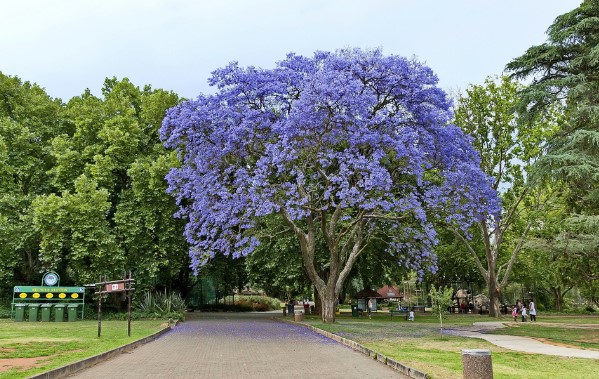
Whether you’re a fan of the purple flowers or simply like the fact that they’re so messy, a jacaranda tree is a great choice for your garden. Not only is it a beautiful flowering tree, but it also has a strong root system that makes it drought resistant once it has been established.
The jacaranda tree is a fast growing tropical plant. It is commonly planted in the south of the United States, but it grows in tropical areas all over the world. It is a popular flowering tree, especially in California.
The jacaranda is a tall tree that can reach heights of 60 feet, making it a great specimen to use in your front yard. It has delicate, compound leaves that reshoot after the flowers have died. It is a tree that grows best in full sun. It blooms in the spring and fall.
The jacaranda tree is native to South America. In its native habitat, it grows in warm climates, but the trees can survive occasional cold snaps. It prefers a sandy soil and well-draining soil.
3. Desert Willow Tree
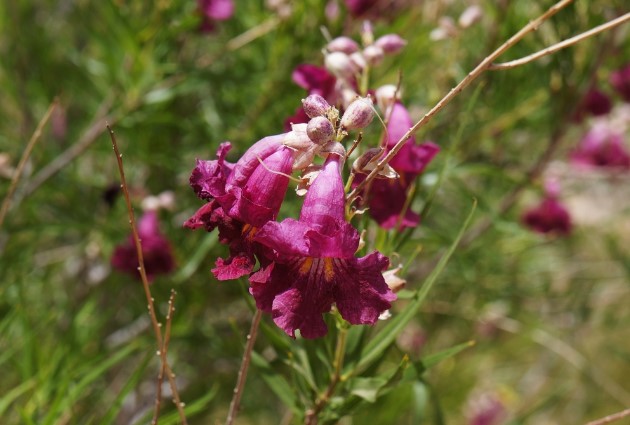
Whether you’re looking for a beautiful, drought-tolerant plant to use as a hedge, or a plant that isn’t susceptible to pests, you should definitely consider Desert Willow. This small tree is easy to grow and has a variety of blooms to choose from.
Natural desert willows grow up to 30 feet tall. They are a good choice for a high-traffic area, such as a pool, garden, or courtyard. They are also a great plant to use for erosion control in arid regions.
The bark of a Desert Willow is light gray on young trees. As the tree grows, the bark becomes rougher and more textured. The leaves are oval and narrow. Depending on the cultivar, the flowers may be white, pink, or purple.
The flowers of the Desert Willow are sweetly fragrant. The clusters of tubular flowers are a showy addition to your garden. They typically bloom in the spring. They are scented and attract hummingbirds and bumblebees.
The leaves of the Desert Willow are glabrous. It is a member of the trumpet vine family. It thrives in well-drained soils and full sun. This plant is a popular landscaping plant in the Southwest, and is available in several varieties.
4. Vitex Tree
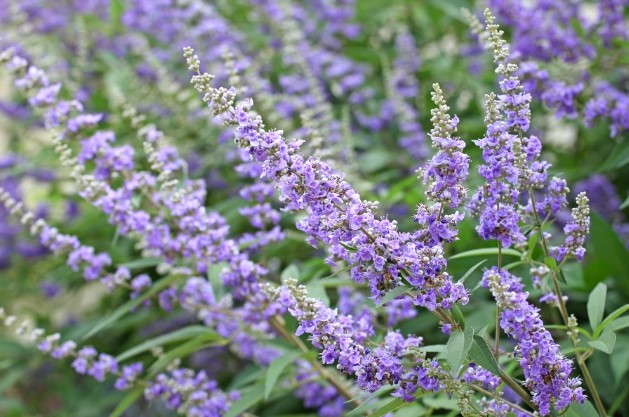
Whether you are looking for purple flowers for your garden or simply want a beautiful landscape, Vitex trees can work for you. They are great for attracting butterflies, bees, and other pollinators to your yard. They are also drought-tolerant, making them a good choice for Xeric gardens. They have a relatively low water requirement, and can survive off of rainwater and residual water in the soil. They are also resistant to pests and diseases.
They are also quite easy to grow, and they are adaptable to many kinds of soil. They can tolerate moist or dry conditions, as long as the soil is slightly acidic. They are also fairly tolerant of salt and heat, so they are a great choice for areas with a hot, dry climate.
They are relatively tolerant of cold, so they can be grown in zones 6 to 9. They are also disease-free and pest-resistant. They are also a good choice for a small or large space, and they are perfect for accenting a pool area.
They are available in several sizes of containers. They can reach a maximum height of 10 to 12 feet. They can be planted in sunny locations or in shade.
5. Chaste Tree
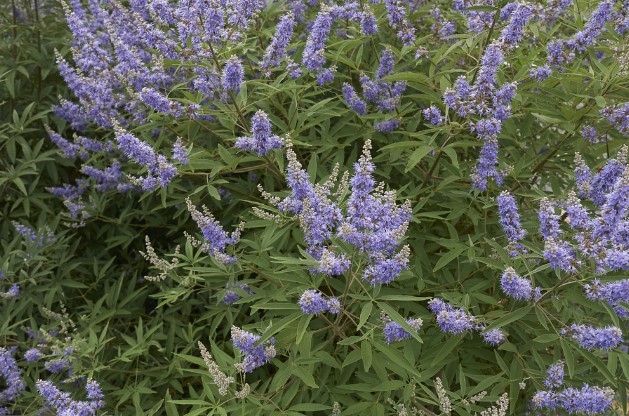
Originally from the Mediterranean region, the Chaste Tree is a tough and drought resistant deciduous shrub or small tree. It is native to southern Europe and Asia. It grows to a height of 10 to 20 feet.
The plant is easy to care for and does well in hot or dry climates. It is also a good choice for container gardens. It tolerates wind, salt, and drought. It is also an excellent honeyplant.
This low watering plant grows best in full sun. It is an attractive accent to other plants with dark foliage. It can be planted in a traditional landscape area as well. The leaves are long, lance-shaped, and have an aromatic fragrance. It also attracts bees and butterflies.
The Chaste Tree is not susceptible to most garden pests. However, whiteflies and nematodes are a risk. They can be controlled by using horticultural soaps.
This small shrub is available in several varieties. Some varieties produce pink flowers while others produce purple. They are perfect for a perennial border or container. The Abbeville Blue, Silver Spire, and Montrose Purple are among the most popular varieties.
6. Dogwood

Whether you want to grow dogwood as a tree, a shrub or a flowering plant, you’ll find that these are a good choice for a home or landscape. They can be planted in a semi-natural setting, but are also great as a screen or specimen. They are also known to grow in swamps, bluffs and floodplains, making them an ideal addition to any yard or garden.
Despite its name, dogwood is a relatively fast-growing woody plant. It grows well in full sun or part shade. However, it requires good soil and a lot of room to grow. It also needs regular watering and light pruning when it is young.
The earliest flowers appear on the tree in late spring or early summer. They are usually white. The fruits ripen in late summer. They are eaten by birds and other animals, but can be dangerous to humans. They contain two ellipsoid seeds.
The leaves of the flowering dogwood are broad and oval in shape with pronounced curved veins. The center vein of the leaf is connected to the petiole. The leaves are generally about five inches long. In the fall, the leaves turn red or purple.
7. Eastern Redbud
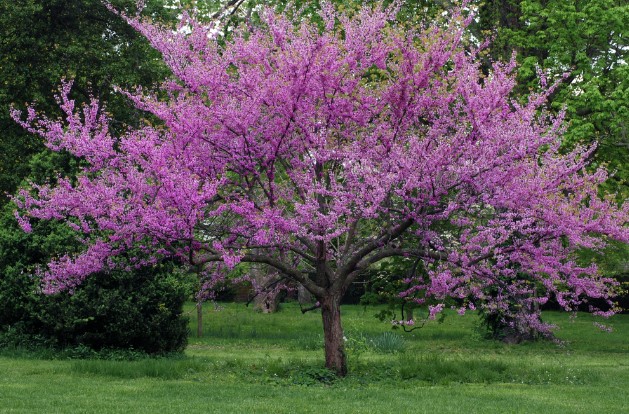
Often found in the wild, eastern redbud is a small tree. It is native to most of the eastern and southern U.S., as well as Canada. It is a small, deciduous tree that grows in moist, well-drained soils. It can be grown in most areas, though it does best in full sun.
Its heart-shaped leaves turn yellow in the fall. The seed pods are oval in shape and contain three to ten seeds. The flowers are about half an inch in length and pea-like in shape. The petals are five in number.
It is a popular landscape plant, especially in home gardens and parks. Its vibrant purple-pink flowers appear in clusters in early spring. They are edible and add a citrusy flavor to salads. It is also good for cooking and can be used as a substitute for capers.
A redbud tree can grow in partial or full shade. Depending on the variety, its leaves can be 3 to 4 inches in diameter. It has a tidy canopy, making it ideal for groupings along woodland edges.
8. Fragrant Lilac
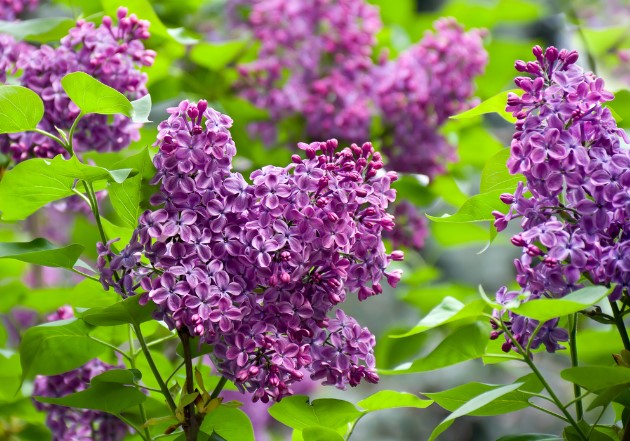
Adding a fragrant Lilac tree to your garden is a great way to add a touch of color and scent. It can also act as a great hedge or screen, making it an attractive addition to your yard. Depending on the species you choose, lilacs may or may not have a strong fragrance.
These plants are easy to care for and will add a fresh look to your yard. They are also extremely hardy, and will thrive in almost any type of soil. They are also a favorite of hummingbirds, which will enjoy the flowers’ sweet scent.
The common lilac is a native to southeastern Europe. It is the longest blooming species within the genus. These plants typically bloom in late spring for about three to four weeks. They have single or double flowers, and are available in a variety of colors.
These lilacs are very fragrant, and the sweet scent will attract hummingbirds to your garden. Their flowers are great for cutting, and their pink buds are a welcome sign of spring. They are also popular with butterflies.
9. Hibiscus Tree
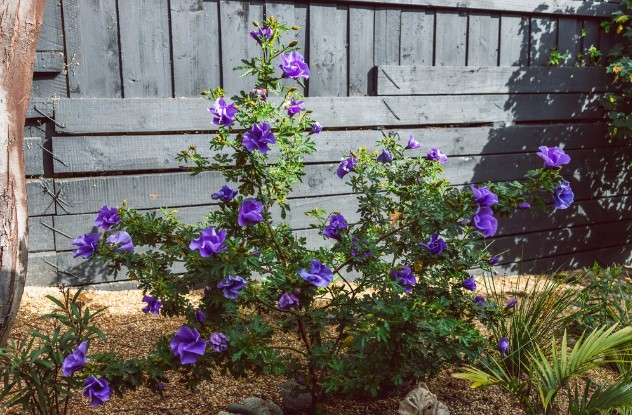
Having a Hibiscus Tree with purple flowers in your backyard can be a great way to add color to your garden. Depending on the type of Hibiscus, they can grow up to 15 feet in height. These hardy plants are resistant to pests and diseases. They are also drought-tolerant. They will thrive in areas with full sun and well-drained soil.
When planting your hibiscus, you can choose to plant it in a pot or plant it in the ground. Whether you choose to plant it in a pot or in the ground, the plant will need to be watered regularly. It also needs magnesium and iron, which are vital to its health. It is best to plant it in a container with drainage holes.
If you are in a warmer region, your hibiscus will grow best in partial shade. During the colder winter months, the plant will go into dormancy. This is because the plant does not like temperatures below 32 degrees Fahrenheit.
In a cooler climate, the plant will tolerate temperatures of about 60 to 90 degrees. If you want to keep the foliage healthy, remove infected leaves from the plant. This will prevent overwintering spores from settling in.
10. Korean Lilac Tree
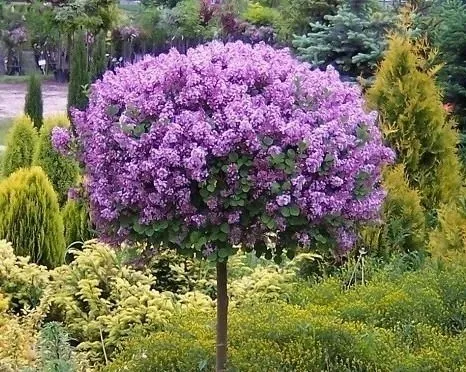
During the springtime, the Korean Lilac Tree offers a stunning display of purple flowers. These fragrant flowers form clusters of lavender and purple. They are the perfect addition to a landscape or patio. They can be found in a variety of flower forms, including trees, shrubs, and even potted plants.
The Korean Lilac Tree needs full sun and well-draining soil to thrive. It’s hardy in USDA growing zones 3-7. It’s also resistant to powdery mildew. It should be watered deeply once or twice a week, but not more frequently in hot weather.
Dwarf Korean Lilac trees should be pruned after they bloom. This will promote healthy growth and encourage the plant to produce more flowers. When pruning, remove all dead branches.
The Korean Lilac tree is a good choice for a cottage garden or solitary accent. It also has a pleasant fragrance that fills the house when the window is open.
Dwarf Korean Lilacs are also ideal for planting in terracotta pots. They require delicate care, but they have the advantage of being less demanding than traditional lilacs.
11. Lavender Twist
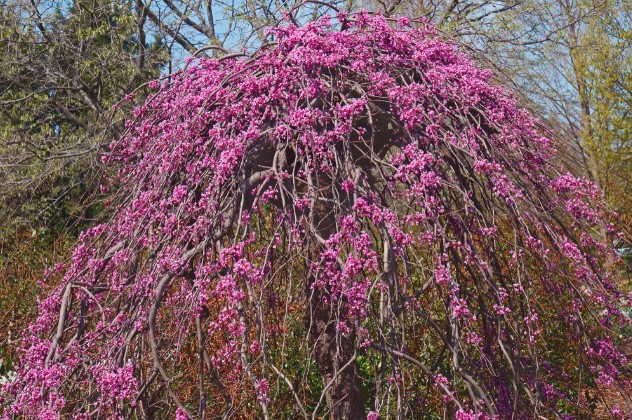
Whether you have a small yard or large space, Lavender Twist can add an interesting element to your landscape. It is a great tree to plant in large containers or to grow in a lawn. Unlike most other trees, the leaves on Lavender Twist have heart-shaped tips, giving it a unique look. The glossy upper surface of the leaf is a rich green. It turns yellow in the fall.
This tree is hardy in zones 4 and 5 but it does well in zones 6-9, as long as it is in full sun. It is also resistant to drought, making it a good choice for hot climates.
This weeping tree produces a profusion of flowers in the spring. The blossoms are about one half an inch across, and they last for three to four weeks. These petals are bisexual and are very attractive to honey bees.
When the flowers are in full bloom, they attract a variety of insects. This makes the Lavender Twist a good tree to plant for hummingbirds and butterflies. In addition, the flowers are beneficial to bees, as they produce nectar for them.
12. Magnolia’ Royal Purple’
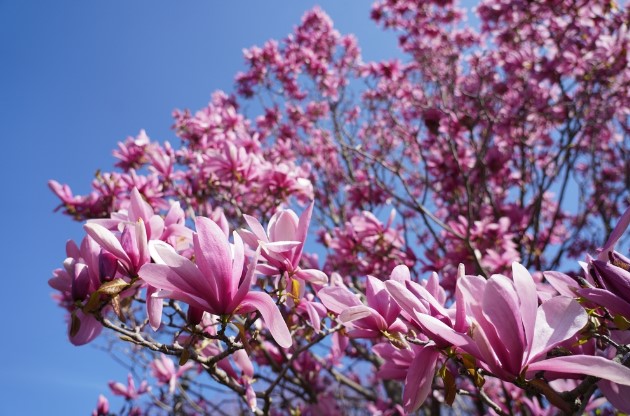
‘Royal Purple’ is a beautiful Magnolia tree with large, bright purple flowers. It is drought resistant, and is a great choice for a feature tree in your garden. It also has the ability to grow in containers. This makes it a great choice for confined spaces.
A small, compact growing tree, this Magnolia is suitable for use in courtyards and as a single feature planting. It is an ideal plant for an espalier training. The leaves turn yellow in the autumn. It has a delicious fragrance.
It is a deciduous flowering tree, and can be used as a feature in a small garden. It grows to about 3 meters high and is ideal for confined space. It is very fragrant and has very large, deep rose-purple goblet shaped flowers.
This Magnolia is one of the Yulan family of magnolias. It is very popular for gardens because of its beautiful, fragrant blooms. In the first ten years of growth, it will grow to about three meters tall.
The ‘Royal Purple’ is also tolerant to frost and can be planted in container growing. Its flowers appear in early to mid-spring, before the leaves emerge. They are cup shaped and are a dark, purple fading to pink. They contrast beautifully with the dark branches.
13. Mountain Laurel

Laurels are native to eastern North America. They are part of the heather family, which includes azaleas and rhododendrons. They are commonly found in upstate New York forests and along the Blue Ridge Parkway in North Carolina.
Mountain Laurels are easy to grow in most climates. However, they are not resistant to fungal disease or leaf spots. They are also susceptible to blights and white flies. They are not suitable for wet or heavy clay soils. They should be planted in a partially shaded area.
Mountain Laurels are often used as informal screen plants. They are also great for mass plantings in shady areas. Their ferny leaves are attractive and their flowers are attractive to butterflies. They are ideal for planting in a butterfly garden.
The Mountain Laurel is a small tree or shrub with showy purple or pink flowers. They can be found in woodland areas as well as in Japanese Hill-and-Pond Gardens. They are a good choice for year-round interest in a garden.
There are many varieties of Mountain Laurel. Some include Snowdrift, which has white flowers. Other varieties include the Elf, which has white blossoms with red markings.
14. Purple Leaf Plum
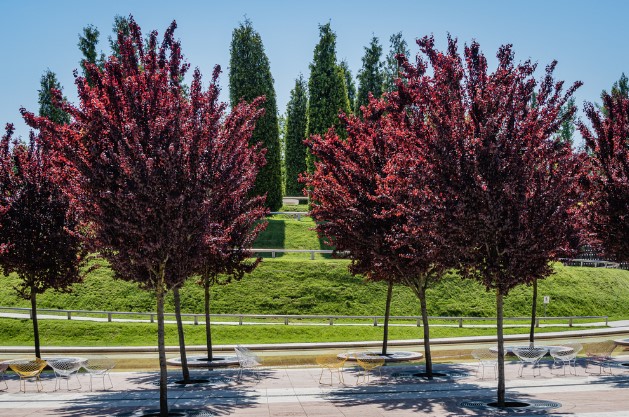
Originally from southeast Europe and Central Asia, the Purple Leaf Plum tree is now naturalized in the United States. It grows well in the southeast, far western, and southwest regions of the country. It can be grown in a variety of soils. It is tolerant to heat, cold, and drought. However, it is best to plant in a location with good air circulation. It will benefit from regular pruning.
The Purple Leaf Plum is a deciduous tree that can grow to a height of 15 feet. It is a great choice for a small garden or yard. It is an ornamental tree that can add color and drama to your landscape. It has attractive pink spring flowers and a beautiful dark purple red fall foliage. It also produces small fruit. The fruit is usually cherry sized and can be eaten raw or made into jam.
The Purple Leaf Plum has an upright crown of many branches. Its leaves are oval with a rounded edge. They mature to a deep reddish-purple color in summer and hold that color through fall.
15. Purple Lily Magnolia
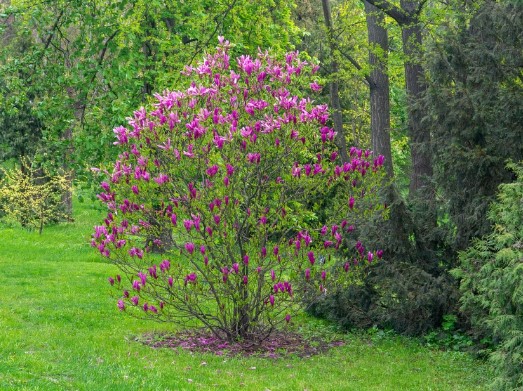
Among the many varieties of magnolia, the purple lily magnolia is known for its large, dark red-purple flowers. It’s a common plant in gardens and parks. It’s also grown as an accent plant.
This shrub grows up to 2 meters high and wide. It’s a hardy spring magnolia. It also has an attractive, creamy-white flower in April.
The tree has a neat, rounded crown and a smooth bark. It is a slow-growing plant.
It grows best in a moist, well-drained soil. It prefers a soil with a pH of 5.0 to 6.5. It also likes to have a layer of mulch in the root zone to moderate soil temperatures.
The magnolia tree can be propagated by seeds or cuttings. However, it doesn’t do well with severe pruning. It is also very susceptible to scale insects. In addition, it is prone to mildew and gray mold.
This shrub will grow in a variety of climates, but it’s best in areas where it can get a lot of moisture and annual precipitation. It will also be susceptible to late frosts. It’s recommended that it be planted in a sheltered spot, avoiding south-facing windows.
16. Purple Orchid Tree
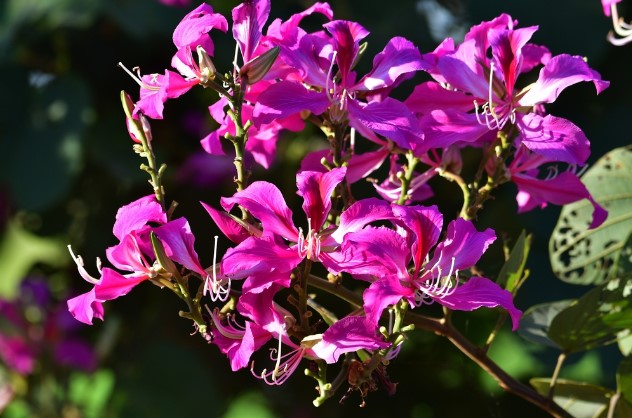
Originally from China and India, the Purple Orchid Tree is a beautiful and exotic tropical tree that will make a lovely focal point in any yard or garden. Depending on how it is cared for, it can grow to between thirty and forty feet tall. The flowers of the tree are fragrant and very showy.
This semi-evergreen shrub grows in warm, subtropical climates. It is a great addition to a Mediterranean or hummingbird garden. It is drought-tolerant once established. It prefers well-drained, moist soil. The foliage is rounded at the base and lobed at the apex.
The flowers are very showy and have five petals and a frilly margin. They are a purple or magenta pink. They are borne in clusters along the stems.
The seeds are brown and are gathered in long seed pods that are six to twelve inches long. They hang tight to the branches into the winter.
The purple orchid tree is a fast growing, multi-stemmed shrub-like tree. It will grow up to thirty-five feet high. It can be grown in the ground or in containers.
17. Purple Robe Locust
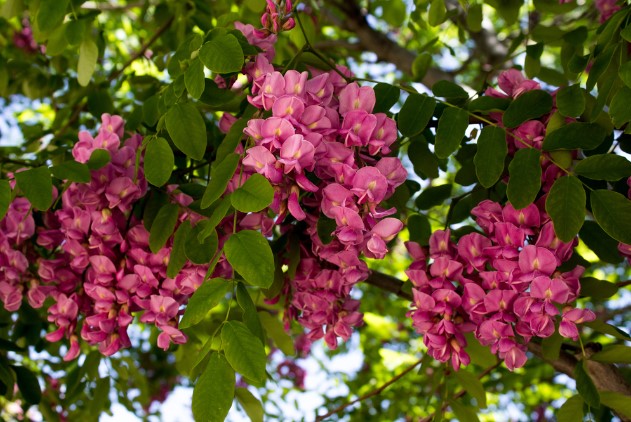
Typically, the Purple Robe Locust grows to about 30 feet and is a very popular landscaping plant. Its flowers are a deep pink or purple. They are very fragrant and are very attractive to bees. The Purple Robe also provides a great deal of shade. It can be planted anywhere and will grow well in a variety of soils.
The Purple Robe Locust tree is a fast growing tree and is very easy to care for. It is also drought resistant when it is planted in the right conditions. It does best in moist organically rich loam. It is an excellent choice for a street tree.
The Purple Robe Locust is a native plant of North America. It grows in the southeastern part of the United States, and is considered to be hardy in U.S. Department of Agriculture zones 4-8. It grows in a variety of soils and can tolerate drought, acidic soils and salt spray.
Its foliage emerges in reddish bronze and then matures to blue green. Its leaves are pinnately compound, and the leaves have six to nine leaflets. The foliage turns yellow in the fall. Its wood is used for firewood. Its bark is also useful for making fence posts.
18. Purple Wisteria Tree
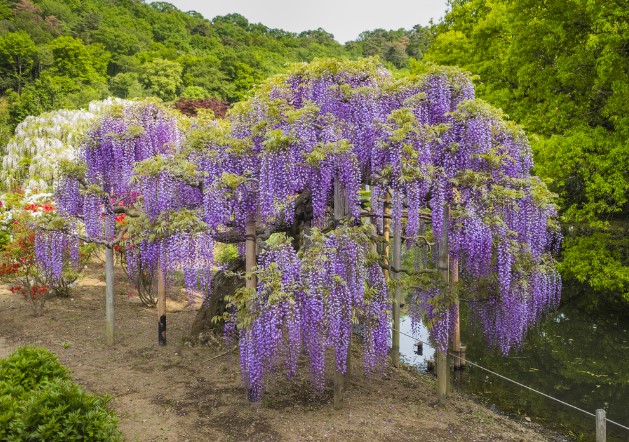
Known for its beautiful purple blooms, the Purple Wisteria Tree can be a great addition to your garden. It can grow in many soils and will tolerate drought. It is a deer-resistant, pest-resistant, and disease-resistant plant. It has been shown to grow up to 15 feet high. It is a versatile plant that can create a dramatic trellis or specimen tree.
In the United States, the most popular variety is the Chinese wisteria, also known as Wisteria sinensis. This variety is widely planted in the US, but is also native to parts of Europe.
There are many varieties of wisteria in the world, including the Japanese wisteria, Wisteria floribunda, and the American wisteria. These varieties all have fragrant purple flowers. However, the Japanese variety is known for its large flower clusters, which are white or lavender in color.
The American wisteria is a native vine, and it has a tendency to bloom in spring, typically between April and May. This plant is hardy to five to nine USDA zones.
Wisteria can reach a height of 30 feet and has a sturdy, drooping stem. They prefer full sun, but can tolerate partial shade. It grows well in medium moisture, but does best in moist but moderately fertile soil.
19. Royal Empress Tree

Despite being considered an invasive species, the Royal Empress Tree is a desirable shade tree that grows quickly, casts plenty of shade and has a long life. This fast-growing tree is also a good choice for deer problems.
This tree has a wide, thick canopy that can be 15 to 30 feet high. The foliage is dense, glossy, and heart-shaped. It’s not known for its fall color, but its attractive green leaves are sure to brighten up your landscape.
In addition to its impressive foliage, the Royal Empress Tree has fragrant flowers. They come in an array of purple and violet shades, and have yellow stripes. In winter, the flowers give off a rust-colored appearance.
The Royal Empress is also drought resistant. This tree can thrive in almost any soil, and is able to tolerate both alkaline and acidic soil. If you want to plant the tree, make sure that you select a spot with a lot of room.
The Royal Empress tree can handle a significant pruning at the beginning of the growing season. However, once it starts to grow, you may need to cut back the tree to maintain a more consistent growth pattern.
In areas where the temperature is cold, the Royal Empress tree can be killed by frost. Its slender branches may be susceptible to damage in high winds. It also has surface roots that spread quickly. The roots can clog underground drainage systems.
20. Royal Purple Smoke Tree
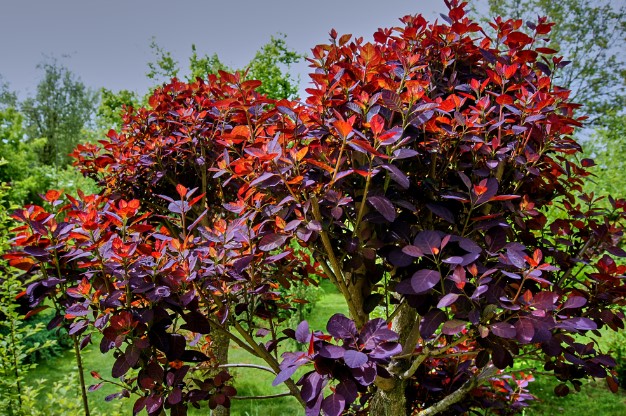
Known for its purple-red foliage, the Royal Purple Smoke Tree is a great choice for your garden. This shrub has a compact growth habit and is resistant to pests and diseases. It thrives in a variety of soils, from a rich, moist sand to dry clay. It is a hardy plant that is resistant to verticillium wilt and rust.
When you buy a Royal Purple Smoke Tree, you can expect to receive a specimen that will grow to a height of 15 feet. It has an open crown and oval leaves that measure 3 inches across. Its unique colors add a splash of color to any landscape.
This beautiful shrub is a perfect choice for landscapes with low maintenance needs. It requires little pruning and is drought tolerant. It also has a long season of bloom. It can be grown as a tree or a multi-stemmed shrub.
Although this shrub is fairly easy to care for, you may encounter some mild problems. It can develop a stem canker and rust. You may have to remove infected foliage, but it is not very dangerous.
The Royal Purple Smoke Tree is a good shrub for a hedge or a border. It has a striking blaze of color in the spring and a rich, plum-purple color in the fall.
21. Silk Floss Tree
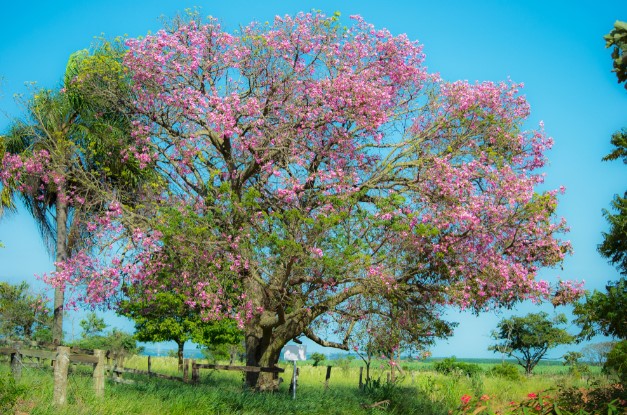
Among the most beautiful plants is the Silk Floss Tree, which can grow to be 60 feet tall. It is a tropical tree that is native to South America. It is a member of the Malvaceae family. It is a tall, tropical flowering plant that is native to Argentina and Brazil. It is often used as a street tree in South America.
The Floss Silk Tree can be a great plant to have in the front yard. It grows to be a large, semi-deciduous tree with palmate leaves. The foliage is pale green and divided into five to seven leaflets. It also has a distinctive trunk with many spines. The Silk Floss Tree can tolerate temperatures as low as 20 degrees Fahrenheit. It is a beautiful flowering tree that is able to stand up to dry conditions and cold weather.
Pink Silk Floss Tree is a versatile plant that can be planted in a wide variety of settings. It will add a bit of color to your garden. It will need six hours of direct sunlight each day and should be watered at least weekly.
The Pink Silk Floss Tree is also a very fast grower. It can become very tall in its first few years. In its adult state, it slows down to a moderate growth rate. It will produce funnel-shaped flowers and woody seed pods. It should be fertilized at least three times a year.
22. Takasago Flowering Cherry
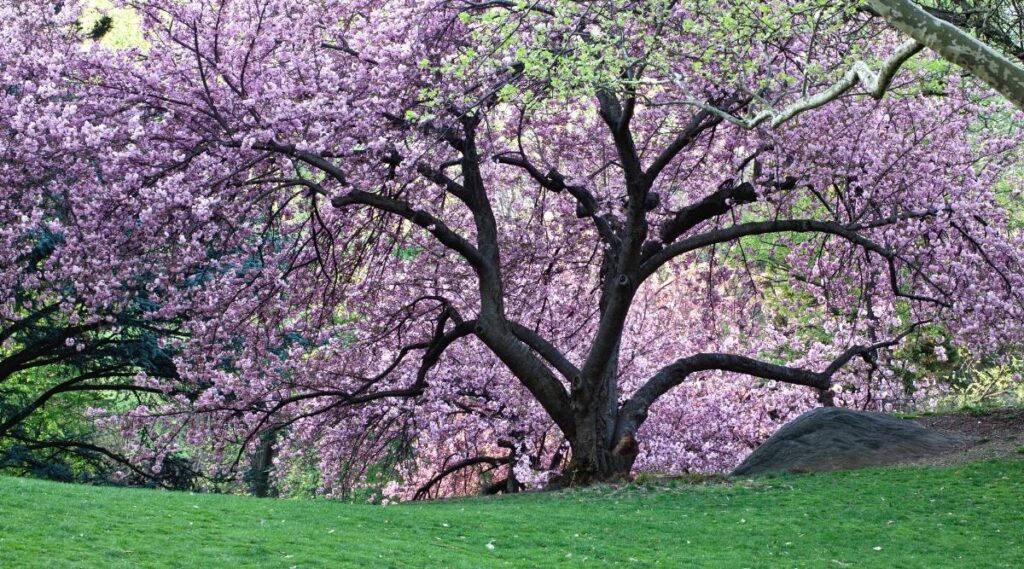
Originally from Japan, the Takasago Flowering Cherry is a deciduous tree with a woody vine and a relatively low canopy. It produces clusters of small fragrant flowers before its leaves emerge in early spring. Its foliage is dark green, with purple centers. The wood can be used for paper and pulp. It can also be braided into a rope.
The Takasago Flowering Cherry can grow up to 30 feet tall and 20 feet wide. It is a very easy to care for plant. The tree can survive for up to 50 years if it is properly maintained. It grows well in a variety of climates and can thrive in urban areas. It is a good choice for front gardens.
The Japanese Cherry tree has pink or white blossoms in the spring. It can be grown in a number of hardiness zones, from zone 5 to 9.
The Takasago Flowering cherry is a popular tree in Japan. It can be found in many public parks. It is considered to be the national flower of Japan. It has a unique flair and is easy to maintain.
Its wood is excellent for making paper and can be braided into a rope. It is considered to be an ideal tree for planting under power lines. It is also a good choice for lawns.
23. Green Ebony Tree
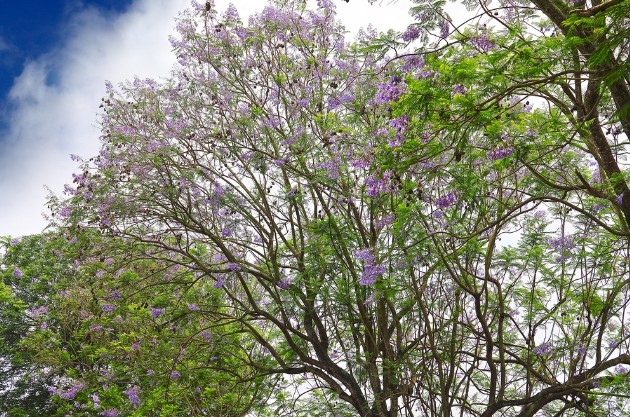
Whether you want to create a lush landscape or just add a bit of shade to your garden, a green ebony tree with purple flowers can be a stunning addition. A semi-evergreen tree, it produces a round canopy of finely segmented mid green foliage that offers an exquisite texture.
The tree’s foliage is highly ornamental and adds a unique, harmonic effect when in bloom. The glossy oval leaves are dark green on top and purple on the underside. They grow up to 6 feet in spread and can be planted in informal and traditional gardens. They require well drained soil.
The ‘Royal Purple’ smoke is hardy in USDA zones 4-8. It has large, thick, pink purple inflorescences. Its regular shape makes it ideal for Japanese and informal gardens. It can also add warmth and appeal to any green space.
The Jacaranda Tree is native to South America. It has become invasive in some parts of the world, but is still widely grown in the United States. It has fragrant, long racemes of pea-like flowers that attract pollinators. Its seeds can easily be distributed by wind. It blooms in late spring.
The tree is usually found in tropical and subtropical regions. It is a favorite nesting site for birds.
24. Princess Tree
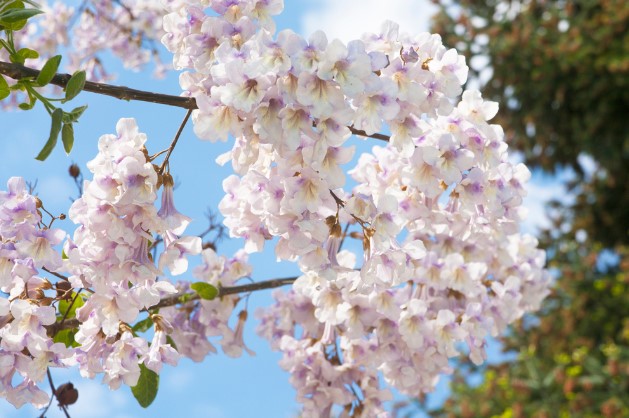
Known as the Chinese empress tree, the princess tree is a fast growing tree with purple flowers. It can grow up to 20 feet in its first year and can be used as a fast shade tree.
Princess tree is native to Central and Western China. It can be grown in a variety of high light environments, including disturbed areas. In its native habitat, the princess tree is a valuable timber species.
The princess tree is popular for its large leaves and showy flowers. It is also a good screen or hedge plant. It can be used in flower beds and as a specimen plant. It is often planted in areas with sunny, well drained soil.
The tree is relatively easy to care for. It is drought tolerant. It grows well in containers and is winter hardy. It should be watered only when the ground is dry. If the ground is moist, it can suffer from mushroom root-rot.
The princess tree has been introduced into Europe and the United States in the early 19th century. It was brought to North America by the Dutch East India Company.
In Europe, it was grown for ornamental purposes. In the United States, it is typically grown as a shrub. The Princess tree is highly sought after for its large leaves and large purple flowers. It has been promoted as a valuable export commodity to Japan.
25. Hong Kong Orchid Tree

Whether you’re looking to add a tropical accent to your garden or you’re just looking to create a beautiful landscape, the Hong Kong Orchid Tree is a wonderful choice. Its large colorful flowers add a splash of color to your landscape, while the foliage makes a great statement. Depending on how you care for your Hong Kong Orchid Tree, it can grow to anywhere from 10 to 40 feet tall and wide.
If you live in an area with a warm climate, the Hong Kong Orchid can tolerate heat. It’s ideal as a specimen tree, but you can also use it as a shade tree. It’s a fast-growing tree that can fill a space quickly.
You can purchase the Hong Kong Orchid tree online or in a local nursery. Once the tree is purchased, you’ll need to carefully remove it from the container and plant it in the ground. Ideally, you’ll want to make sure the soil is well-drained.
The Hong Kong Orchid Tree can thrive in a variety of soil conditions. It prefers a sandy soil, but is tolerant of acidic soil. It is also a drought tolerant plant once it’s established.
This beautiful tree has long blooms that attract birds and butterflies. It can be planted in full sun or in partial shade.
26. Royalty Crabapple Tree

Adding a crabapple tree to your landscape can create an eye-catching display that is attractive to both humans and wildlife. This ornamental tree grows to about 15 feet tall and has beautiful purple leaves and reddish-purple flowers. The fruits are edible, and the berries are used to make crabapple jelly.
Malus ‘Royalty’ is a compact, dense deciduous tree that produces a large amount of fruit. The fruits are deep red and can reach about two inches in diameter. It is drought-tolerant once established and grows in moderately fertile soil. The foliage turns a bright, reddish-purple in the fall.
Malus ‘Double-flowered Prince’ is another variety that grows in an upright, spreading shape. The branches grow higher than the ‘Royalty’ plants, and are reddish brown when they are one year old. ‘Double-flowered Prince’ also shows good branching ability.
The Sugar Tyme (‘Sutyzam’) is another crabapple that produces small, glossy red fruits. The foliage is disease-resistant and has attractive muted fall color.
The ‘Adams’ flowering crabapple is known for its abundance of deep pink blooms. This cultivar is resistant to powdery mildew and produces small, glossy red fruits.
Royalty Crabapple Tree is a wonderful addition to any landscape. The fruits are edible and the colorful foliage adds color to the yard. The tree can be planted as a focal point, in front of a driveway, or as an accent tree.
27. ‘Genie’ magnolia Tree
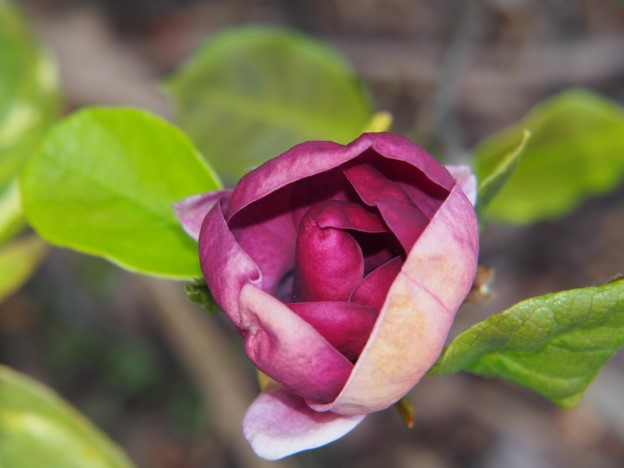
‘Genie’ magnolia is a hybrid cultivar of Magnolia liliiflora and Magnolia soulangeana. It is a compact deciduous tree that grows up to 15 feet tall. It is very low maintenance and perfect for smaller spaces. The trees grow well in clay, sandy and loam soils. It is very adaptable to city gardens and cottage gardens. It is also hardy in zones 5 through 8 and can be grown in the ground or in decorative containers.
When young, the Genie will grow 18 to 24 inches a year. The foliage is rounded and green on the top, while the bottom is a shiny gray color. In autumn, the leaves turn a coppery bronze.
The flowers are light purple or reddish. The petals are tulip-shaped, and the blooms open in late spring. They are very fragrant, and re-bloom throughout summer.
The Genie magnolia can be planted in a variety of soils, but the best growing conditions are those that are rich, acidic and moist. It is best to plant the tree in full sun, although it will tolerate part shade.
The flowers are fragrant, and the trees are easy to care for. The Genie can be planted in containers or in the garden.
28. Lavender Rose of Sharon Althea Tree
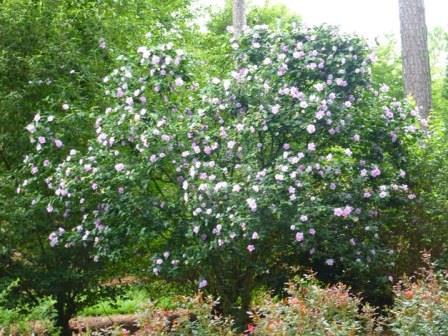
Unlike other types of roses, Lavender Rose of Sharon Althea trees produce huge double blooms of blue-purple flowers. They also have bright green leaves. They will flush out in the Spring and go dormant in the Fall. Typically, the shrub will grow to about 8 feet tall. It can be used as a solitary accent, or planted in a group for a flowering hedge.
The Lavender Rose of Sharon Althea tree grows well in tight spaces, especially in a corner. It is perfect for the patio or garden. It also makes a great privacy screen. The shrub is able to tolerate heat, humidity, and urban conditions. It is also very low maintenance. Its roots will grow deep into the soil, making it an ideal foundation plant.
The Lavender Rose of Sharon also has a long blooming period. It is able to bloom from mid-summer to early fall. The plants are easily propagated by stem cuttings. This shrub also makes a good hedge. The foliage is also salt tolerant.
The Rose of Sharon is a hardy shrub. It can tolerate a variety of soils, but it prefers a soil that is average to moist. It is also a great plant for pollinators. They love the pollen and the ivory stalk is full of nectar.
29. Rose of Sharon
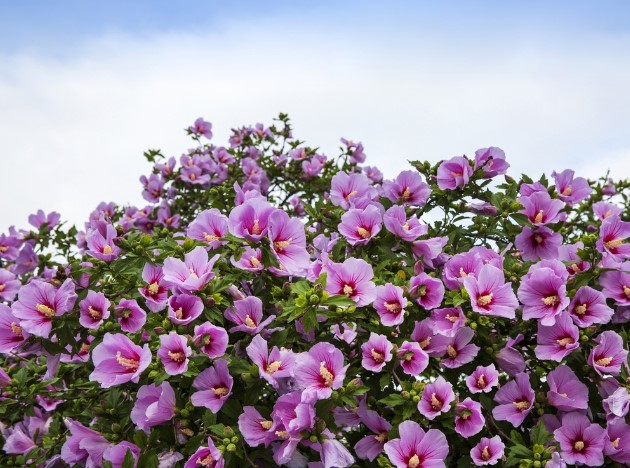
Whether you have a small garden or a large yard, a Rose of Sharon tree is a beautiful addition to your landscaping. These low-maintenance trees are able to thrive in any type of soil, and they can be grown in containers or planted in the ground.
They are also highly pest-resistant, making them an ideal landscape plant. They can be used as a hedge, or they can be grown in groups to create a border. They can be cultivated in a variety of different soil types, from well-drained to slightly acidic.
Depending on the cultivar, the rose of Sharon can grow to be 8-12 feet tall. It can be grown in partial shade or full sun. It is also a drought-tolerant plant.
In order to maintain the health of your rose of Sharon, you should fertilize it regularly. This can be done with a controlled-release fertilizer. Mix it with water and spray it on the leaves. You can also use a fungicide to help control fungal diseases.
You should also check the roots of your Rose of Sharon regularly for damage. Aphids and Japanese beetles can be a problem, and you should treat the roots to prevent them from damaging your plant.
